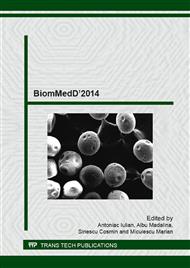p.177
p.183
p.191
p.197
p.205
p.210
p.216
p.222
p.228
A Medical Insight on the of Biomaterials for Cranioplasty Surgery
Abstract:
Cranioplasty represent surgical repairs of defects or deformities of the skull which may come as a result of trauma or congenital malformations. The notable advance in cranioplasties came with the experimental groundwork in bone grafting, performed in the late 19th century, based on which, the use of autografts for cranioplasty became popular in the early 20th century. With the First and Second World Wars alternative metals and plastics were needed to cover large cranial defects suffered in combat as precious metals became scarce. As time passed metallic bone substitutes have gradually become obsolete and modern non-immunogenic plastics such as Polymethylmethacrylate (PMMA) snf Polyetheretherketone (PEEK) replaced them, the major downside of the technique being represented by the high costs. The authors present a statistic of 25 patients treated over a period of 4 years in 3 major neurosurgical units – which beneffited from the neurosurgical use of biomaterials for the repair of major cranial defects following congenital malformations, post-surgical cranial defects or trauma of the skull. We excluded large bone flaps for decompressive craniotomy. The authors used PMMA (Polymethylmethacrylate) and PEEK-based implants. There were 12 cases in which PMMA was used and 13 cases in which PEEK-based implants were used. The authors present a personal comparrison between the two materials. At the same time, the authors perform a comprehensive review of how the techniques have evolved from simple metal to modern biopolymers and how the modern technology will impact the future of cranial reconstruction
Info:
Periodical:
Pages:
205-209
Citation:
Online since:
March 2015
Authors:
Keywords:
Price:
Сopyright:
© 2015 Trans Tech Publications Ltd. All Rights Reserved
Share:
Citation:


